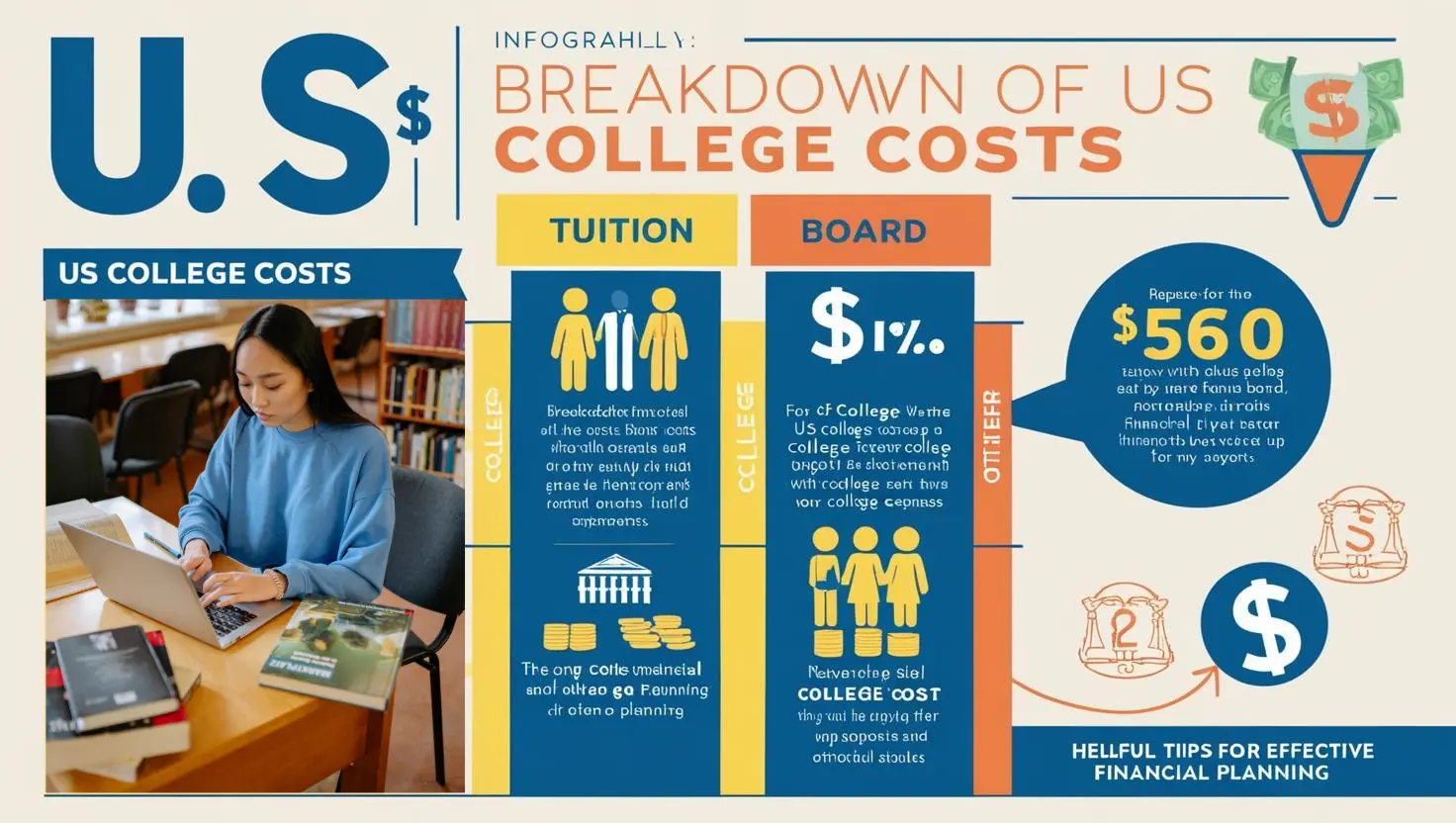
College costs in the US have been a significant concern for students and their families for many years.
The rising expenses associated with attending college, including tuition fees, accommodation, and textbooks, have made higher education increasingly inaccessible for many.
According to recent data, the average cost of tuition and fees for the 2023-2024 academic year was over $40,000 at private colleges and around $10,000 at public institutions for in-state students.
These figures highlight the substantial financial burden that college costs in the US place on students and their families.
Moreover, the cost of living, such as housing and food, adds to the overall expense, making it even more challenging for students to afford a college education.
As a result, many students rely on financial aid, scholarships, and loans to cover these college costs in the US, which can lead to significant debt upon graduation.
Average College Costs in The US
College costs in the US have become a pressing issue for many students and their families, as the expenses associated with higher education continue to rise.
The term college costs in the US encompasses a wide range of financial burdens, including tuition fees, accommodation, textbooks, and other living expenses.
According to recent data, the average cost of tuition and fees for the 2023-2024 academic year was over $40,000 at private colleges and around $10,000 at public institutions for in-state students.
These figures underscore the significant financial challenges that college costs in the US present to students and their families.
Additionally, the cost of living, such as housing and food, adds to the overall expense, making it increasingly difficult for students to afford a college education without substantial financial aid or loans.
Understanding the Core Components of College Costs in the US
When discussing college tuition costs, it’s important to break down the different categories that contribute to the overall expenses of attending a university or college in the US:
- Tuition and Fees: These are the core costs for academic instruction.
- Room and Board: The cost of living, whether on-campus or off-campus.
- Books and Supplies: Textbooks, learning materials, and other supplies required for coursework.
- Additional Expenses: Transportation, technology, and personal living expenses.
Public vs. Private College Tuition Costs
One of the primary distinctions in college tuition costs is between public and private institutions.
The difference in cost can be staggering, and the decision to attend either type of school will depend on various factors such as academic goals, financial resources, and location preferences.
Public Colleges: In-State vs. Out-of-State Tuition
Public colleges and universities are funded by state governments, which often results in lower tuition rates for in-state students.
However, out-of-state students typically face significantly higher costs.
For instance, at a state university, in-state students might pay around $11,000 per year, while out-of-state students could be charged nearly three times that amount, exceeding $30,000.
Private College Tuition Costs
Private institutions, which rely on tuition and private funding, generally have higher tuition rates than public schools.
These costs can range from $30,000 to over $60,000 annually.
However, private colleges also tend to offer substantial financial aid packages that can offset the sticker price for many students.
To learn more about public vs. private tuition differences, visit College Board’s Trends in College Pricing.
Hidden Costs of College: Room, Board, and Beyond
While tuition is the most talked-about cost, it’s far from the only one.
Room and board can significantly add to the overall cost of attending college, with prices varying greatly depending on the location and type of housing.
On-Campus Living vs. Off-Campus Living
On-campus housing costs can range from $10,000 to $15,000 annually, depending on the school and location.
Living off-campus can sometimes be cheaper, but additional expenses such as utilities, groceries, and transportation must be considered.
Many students also choose to share housing to lower costs.
Books, Supplies, and Technology
The cost of textbooks has long been a point of contention, with some students spending over $1,000 per year.
In recent years, digital textbooks and open educational resources (OER) have become more popular, offering more affordable alternatives.
College Costs Based on Location and Institution Type
Community Colleges: An Affordable Alternative
Community colleges offer a more affordable path for students, with average annual tuition costs of around $3,860 for in-district students.
Many students begin their education at community colleges and then transfer to four-year universities, which can significantly reduce the overall cost of obtaining a degree.
State Universities vs. Elite Private Colleges
While state universities provide a balance between quality education and affordability, elite private colleges like Ivy League schools charge some of the highest tuition rates.
However, these institutions often offer generous financial aid packages.
For example, Ivy League schools like Harvard and Princeton have financial aid programs that cover full tuition for students from families earning less than $65,000 per year.
For more on financial aid and tuition policies at elite schools, check out Harvard’s Financial Aid Office.
Financial Aid and Scholarships: Reducing College Costs
Fortunately, financial aid plays a critical role in making higher education more affordable.
Scholarships, grants, and work-study programs can significantly reduce the college tuition costs faced by students and families.
The Importance of FAFSA
The Free Application for Federal Student Aid (FAFSA) is the gateway to most forms of financial aid, including federal grants, loans, and work-study opportunities.
Submitting the FAFSA on time is crucial for receiving the maximum amount of aid.
Types of Financial Aid Available
- Grants: Federal Pell Grants and state grants are need-based and do not require repayment.
- Scholarships: These are merit-based awards that can come from schools, private organizations, or the government.
- Loans: Federal and private student loans are available, but unlike grants and scholarships, they must be repaid with interest.
- Work-Study: A program that allows students to work part-time while attending school, earning money to cover educational expenses.
The Impact of College Costs on Students and Families
The rising college tuition costs have far-reaching impacts on both students and families.
Many students graduate with significant debt, which can influence career choices, homeownership, and other financial decisions for years after graduation.
Student Loan Debt in the US
Student loan debt in the US has surpassed $1.7 trillion, with the average borrower owing approximately $30,000 upon graduation.
This financial burden often delays major life milestones such as buying a home, starting a business, or even saving for retirement.
Deciding on a College Based on Cost
Given the high costs of college, many families are now factoring in tuition and financial aid packages when deciding which college to attend.
Tools like the College Scorecard from the U.S. Department of Education allow students to compare College Costs in the US and financial aid offerings of different institutions.
Trends in College Tuition Costs and Projections for the Future
Past Trends in College Tuition Costs
Over the past two decades, tuition at public four-year institutions has risen by 68%, and private college tuition has seen similar growth.
These increases outpace inflation and wage growth, leading to widespread concerns about the affordability of higher education.
What to Expect in the Coming Years
Experts predict that college tuition will continue to rise, albeit at a slower pace due to increased public scrutiny and pressure for reform.
Additionally, the growing availability of online education options could provide a more affordable alternative for some students.
Tips for Managing College Costs
Budgeting and Planning Ahead
One of the best ways to manage the high cost of college is to create a comprehensive budget. Include all potential expenses—tuition, housing, books, transportation, and personal expenses. Planning ahead can help families save and prepare for these costs over time.
Exploring Affordable Alternatives
Consider less expensive options such as community colleges, public universities, or in-state schools. Also, explore online degree programs, which often have lower tuition costs and allow for greater flexibility.
Conclusion: College Costs in the US
College tuition costs in the US can be overwhelming, but understanding the various factors that influence College Costs in the US and exploring financial aid options can make higher education more accessible.
From differences between public and private institutions to managing additional expenses like room and board, planning for College Costs in the US requires careful research and preparation.
As tuition continues to rise, students and families must remain proactive in finding ways to reduce expenses and secure financial aid.
By keeping informed and exploring all available resources, students can pursue higher education without sacrificing their financial future.


